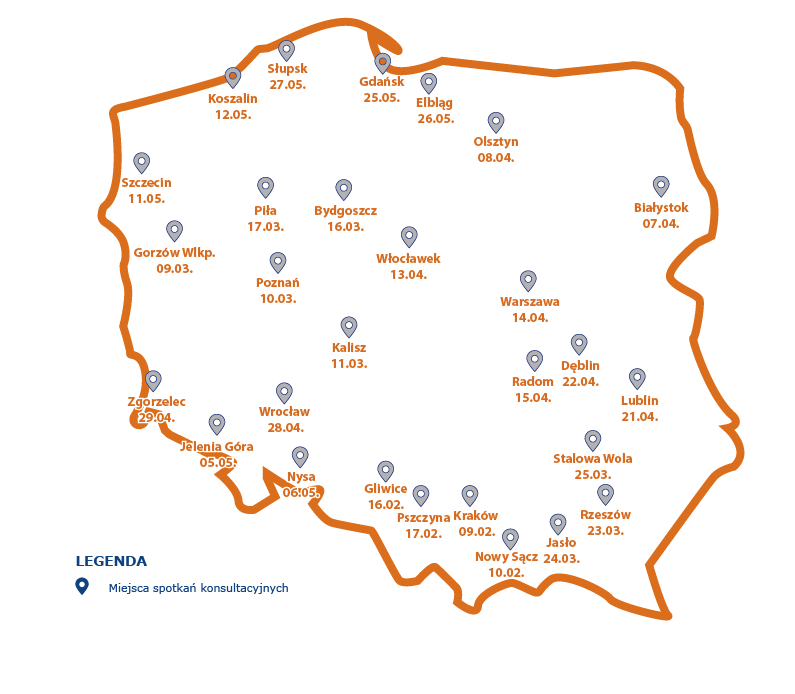Specific proposals of activities for basins are ready, as indicated in the draft updated plans of flood risk management. An example of such activities is e.g. “The Repair of Embankments of the Długa river in the Oder Basin” or “the Development of the Reforestation Concept in the Warta Water Region” which is a non-technical one. All the same, Państwowe Gospodarstwo Wodne Wody Polskie which implements the project would like to inform that the draft plans will be submitted for six-month public consultations on 22 December, according to the schedule.
The public consultations will last till 22 June 2021. The consultation meetings will take place in 28 towns and cities in Poland. The meetings’ essence will be the conversion of general methodology-related assumptions and conclusions drawn from analytical works carried out to actions protecting residents, economy, environment and cultural heritage in areas of particular river basins. The project has an unprecedented scale also because of the safe online form necessitated by the pandemics. The venues and dates of the public consultations devoted to uFRMP are presented in the map below:

On 8 December, during the third conference within Stop Flooding project, the results of analyses carried out in the basins of the Vistula, the Oder, the Elbe, the Pregoła, the Niemen and the Danube, summarising the existing issues and needs concerning flood risk minimisation, were presented for the first time. This time, the expert meeting had a motto: “River Basins. Safety. Plans”.
The basins of the largest Polish rivers, i.e. the Vistula and the Oder, particularly in their upper sections, are of key importance for the flood safety of Poland. Implementation of plans from the first planning cycle, due to many development processes started before, focused largely on measurable actions connected with reducing the flood risk in the Oder basin. It was crowned by handing over the Dolny Racibórz reservoir, the largest hydrotechnical structure of that type in Poland in mid-2020, protecting close to 2.5 million of residents of towns and cities in the Voivodeship of Silesia, Opole and Lower Silesia who were so heavily afflicted by the flood in 1997. Specific activities were initiated also in the Vistula basin.
“During this planning period, we focused on completing the activities reducing the flood risk in the Oder basin and initiated a cycle of specific solutions for the Western and Eastern part of the upper Vistula which we considered to be trouble spots during the previous planning period. We indicated then that e.g. Kraków needs protection. We spent 6 years carrying out relevant analyses which is why we can propose complete solutions now. Kraków is a proof of implementing the first plans and initiating the required activities. However, there are much more specific solutions for the upper Vistula region, including e.g. the activities in Sandomierz, Tarnobrzeg and other smaller towns and villages. The cooperation between various administrative bodies is important for us as well it is possible to fight this immense and unforeseeable element, i.e. flood, only if we are together”, said Krzysztof Woś, Deputy President of Państwowe Gospodarstwo Wodne Wody Polskie.
The activities suggested in the plans are national, regional or local. Depending on the scale of the identified problems in a given water region, sets of activities were proposed for the indicated problem areas to reduce them. Apart from the strictly investment activities, there are many tasks supporting the flood management system and formal legal instruments supporting performance of uFRMP activities. Moreover, it includes activities referring to the spatial development, considering the development limitations in the areas exposed to flood hazard. Appropriate spatial planning is the basic activity conducive to flood risk limitation by leaving areas exposed to flood risk undeveloped, leaving enough space for the river to ensure flood water is able to run off freely, without contributing to any immense damage and losses.
The FRMP update is the final component of the series of documents concerning flood risk, prepared during the second planning cycle specified by the EU Flood Directive (Directive 2007/60/EC of the European Parliament and of the Council of 23 October 2007), the provisions of which were incorporated into the Polish Water Law in 2012. The cycles last six years and comply with the following schedule: initial flood risk assessment — development of flood hazard maps — development of flood risk maps — development of flood risk management plans. During the second cycle, the documents were reviewed and updated at all stages. The last cycle component is the draft discussed today, called “The Review and Update of Flood Risk Management Plans (FRMP)”. During two previous conferences, the methodology of updating FRMP and the purposes and directions of the necessary activities minimising flood risk were presented.
Wody Polskie implements the requirements of the Flood Directive incorporated in the Polish Law act. It obliges us e.g. to prepare numerous planning documents concerning flood risk. The strategy recommended in them rests on three pillars. The first is to take the flood away from people e.g. by recommending construction of storage reservoirs and embankments as well as activities related to the natural retention. The second is to take the people away from the flood by the appropriate spatial planning to avoid construction of residential buildings in particular in the flooded areas. The third pillar recommends learning to live with the flood and its management as efficiently as possible, coping with it in its course and afterwards e.g. by building early warning and prognosticating systems, broadly-taken flood education, including in relation to insurance, building preparation for flood etc. Social awareness is of immense importance to reduce the risk and possible losses. It enables to carry out rescue more efficiently and return to the pre-flood condition more effectively.

